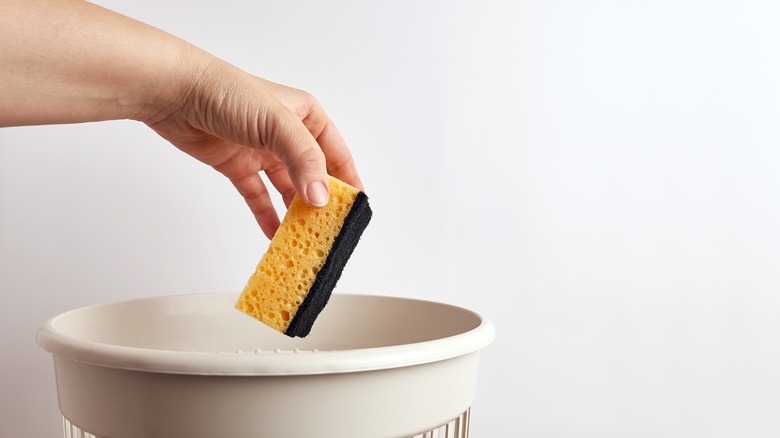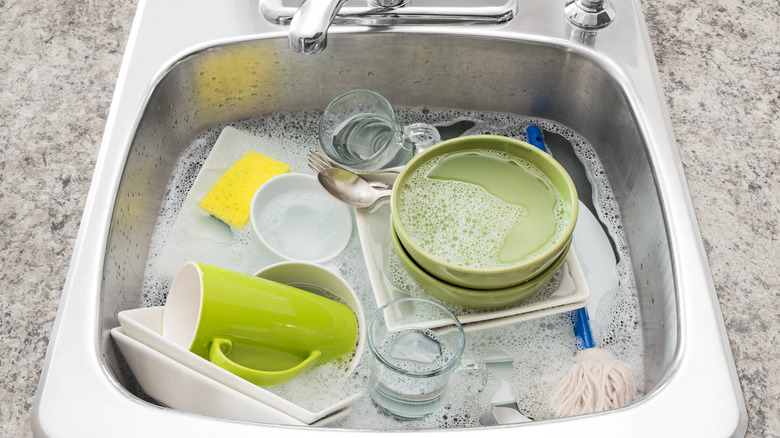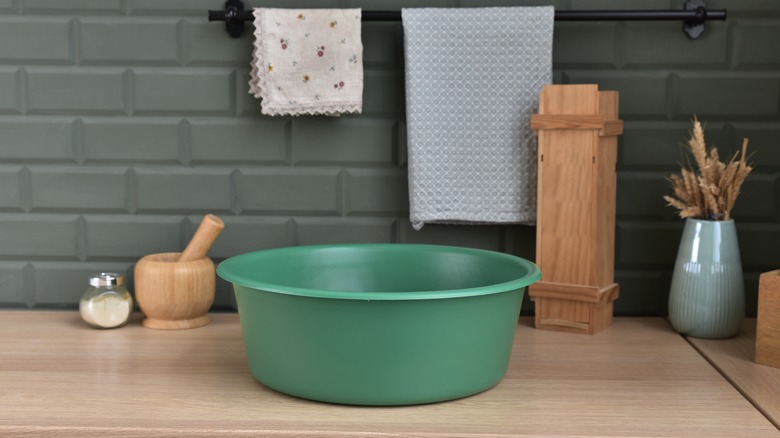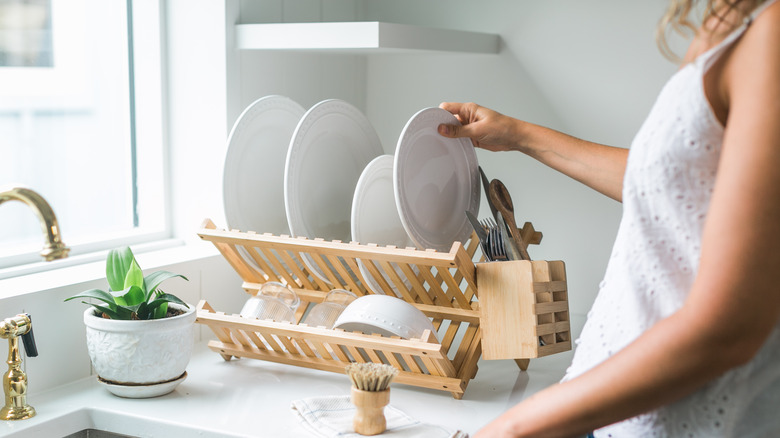How To Properly Hand Wash Dishes
Did you know that dishwashers are one of the least used large appliances in the home? Almost 70% of homes in the United States have one, but 20% of homeowners rarely or never use it (via U.S. Energy Information Administration). Some people who choose not to use their dishwasher treat the appliance as additional storage, but many others use it as a drying rack for hand-washed dishes. While hand-washing dishes isn't everyone's idea of a good time, the practice has some key benefits. In addition to being meditative and boosting your immune system, where else will you find the time to give your undivided attention to your newest podcast or audiobook addiction?
Whether you prefer washing dishes by hand or you're just counting down the days until you can buy a dishwasher, it's essential to wash them correctly. Failing to remove gunk and sanitize your dishes can lead to illness, and eating off of gross, crusty plates is never fun. Thankfully, all it takes to achieve a deep clean is following a few simple steps.
Skip the sponge
Sponges can play host to nasty bacteria, including salmonella, campylobacter, norovirus, E. Coli, and staph (via Livestrong) — stuff you don't want to ingest accidentally. Using a sponge may be fine if you follow up with a dishwasher cycle because the high heat kills most bacteria, but when hand-washing dishes, you should be wary of your sponge. It's much better to wash your dishes with your hands and gently rub the soap over dirty areas; just make sure you wear gloves to avoid drying out your skin or cutting your hands on a hidden blade.
Another good reason to skip sponges is that they're often too rough on dishware. Rough sponges can scratch plates and mugs, creating microscopic hideouts for bacteria. Abrasive sponges can also break down the coating on nonstick pans, causing them to emit PFOAs and PFAs into your food (via Healthline). However, if you can't resist using a sponge on your dishes, don't worry. You just have to focus on adequately eliminating bacteria.
Start with a soak
Most people use too much dishwashing liquid when only about a teaspoon can take care of a full sink. One way to save money on dish soap and ensure your kitchenware gets a better clean is to fill a plastic tub or the kitchen sink with hot, soapy water before you start. If you add a small amount of dish soap under the running water, your sink will fill up with suds in just a few minutes, and your soap will be evenly distributed. For extra cleaning power, opt for an antibacterial dish liquid.
After scraping away any leftover food, leave your dishes to soak in hot water for at least ten minutes. This will help to loosen up any crusty food left on the dishes and make them easier to wash. Don't soak wooden or bamboo tableware, as that may cause them to swell, crack, or get moldy. When you're done soaking, start washing the small items, such as silverware, cups, and measuring spoons. These are usually the least dirty items and won't soil the water as quickly. Next, work your way up to dirtier items like pots and pans, then drain the dirty water.
Rinse and sanitize
Some might say that a simple wash and rinse is enough, but if you want to wash your dishes the right way, you'll want to sanitize them. First, prepare your sanitizing rinse by filling a bucket or sink with warm water. Next, add a teaspoon of regular bleach for every gallon of water or roughly two tablespoons for a large sink (via Clorox). After you've washed away all the visible food and grease, rinse your dishes under the faucet, then plunge them into the sanitizing bath for about two minutes. While you're at it, drop your sponge in too!
Don't worry — when it's diluted with water, a little bleach won't be strong enough to hurt you if a small amount is dried and ingested. However, this sanitizing step is crucial for items that come into contact with raw meat, such as cutting boards and butcher's knives, as these tend to harbor the most illness-causing bacteria.
Air dry if possible
After two minutes have passed in the sanitizing bucket, pull your dishes out and set them in a drying rack (or your dishwasher racks) to air dry. There's no need to rinse or wipe after sanitizing; any remnants of the bleach mixture left behind should evaporate as the dishes dry. Unfortunately, air drying will take up real estate in your kitchen, but only for a little while. To make the time pass quicker, you can invest in a decently-sized dish rack made of bamboo or another aesthetically pleasing material. This will enhance the look of your kitchen more than a cheap plastic or wire dish rack.
It's best to air dry your dishes to limit any bacteria that could be transferred from a dish towel, but if you have to towel dry to make space on your counter, always reach for a clean, fresh towel. Once the dishes have completely dried, stack them in your cabinets, and you're done — at least for a day or two!




